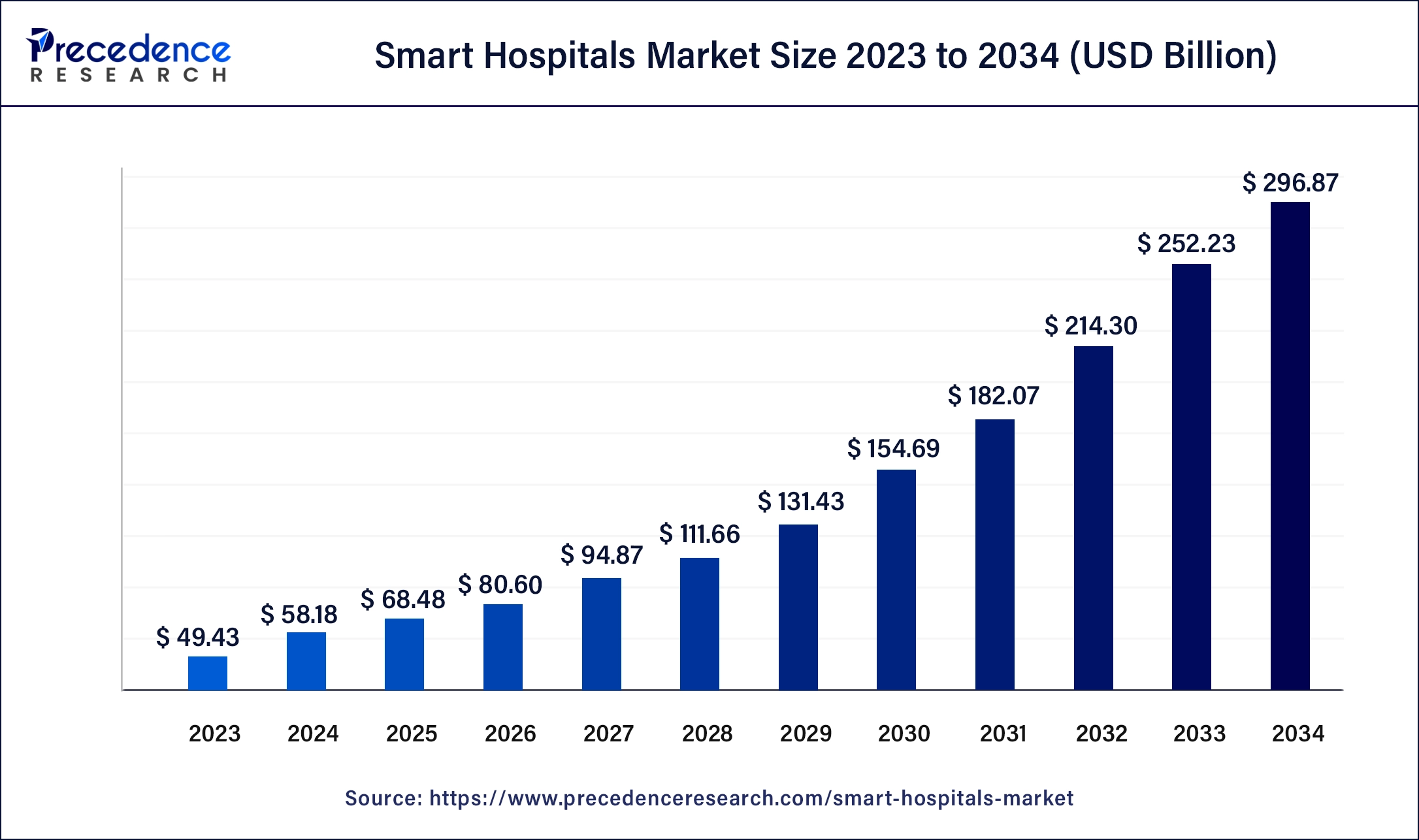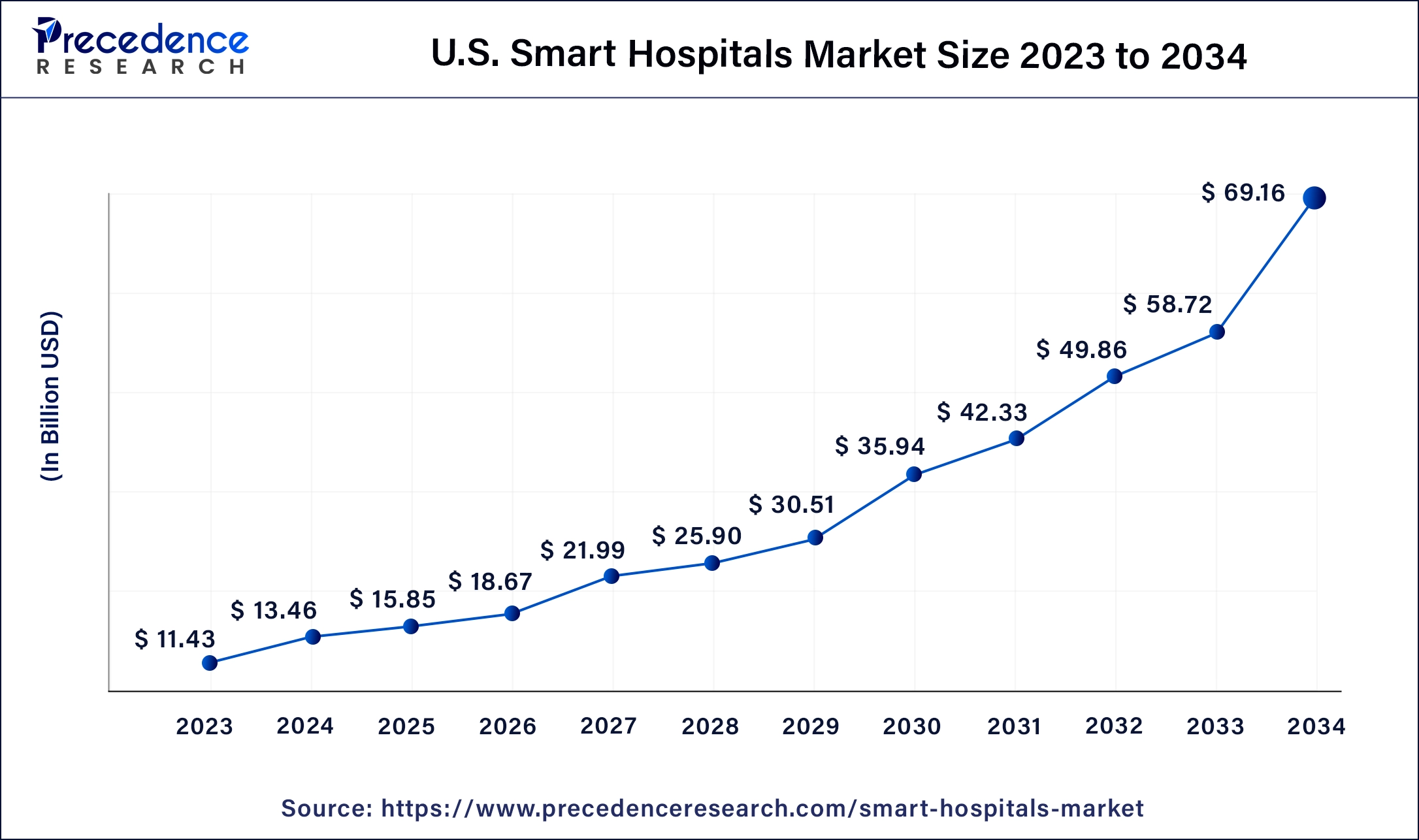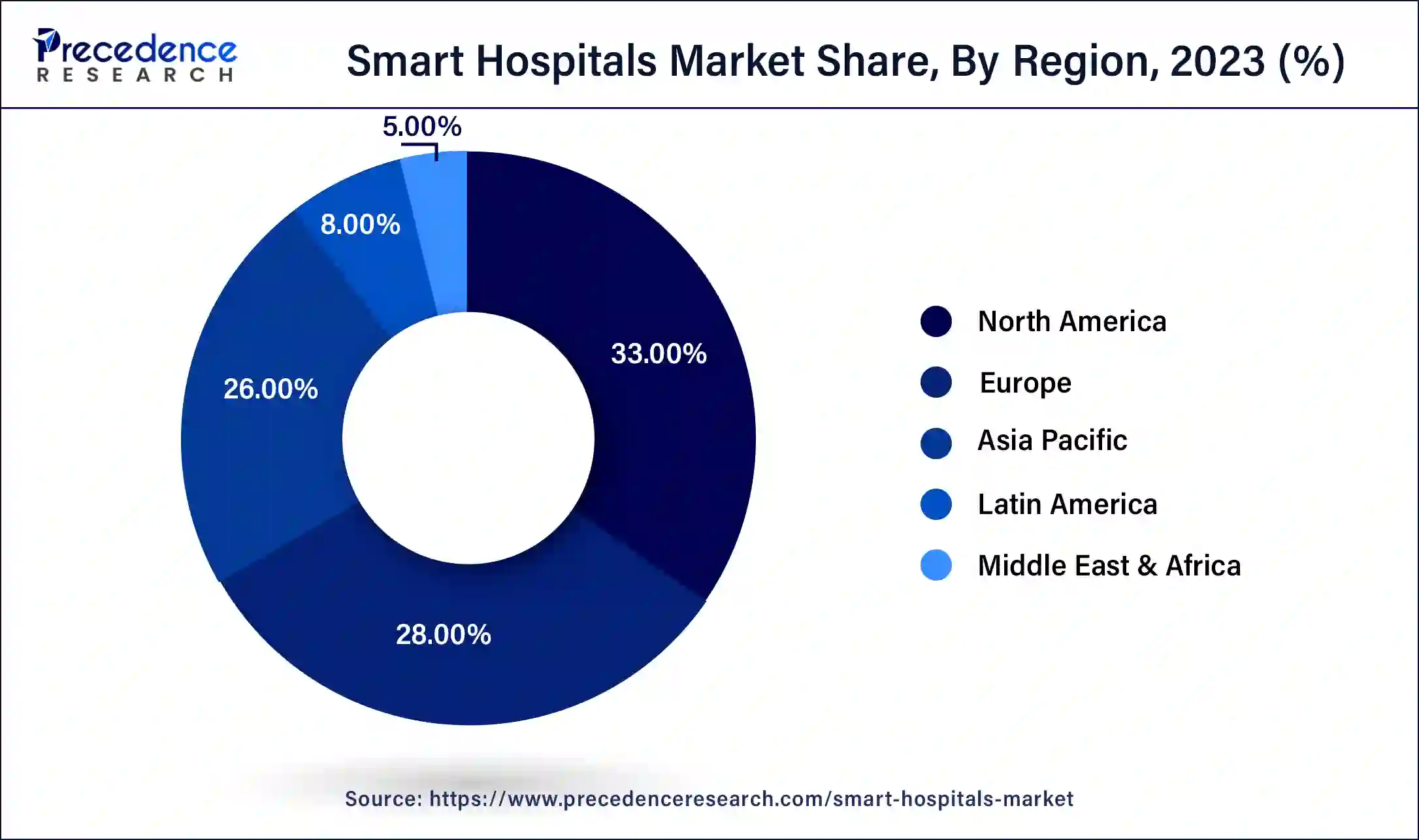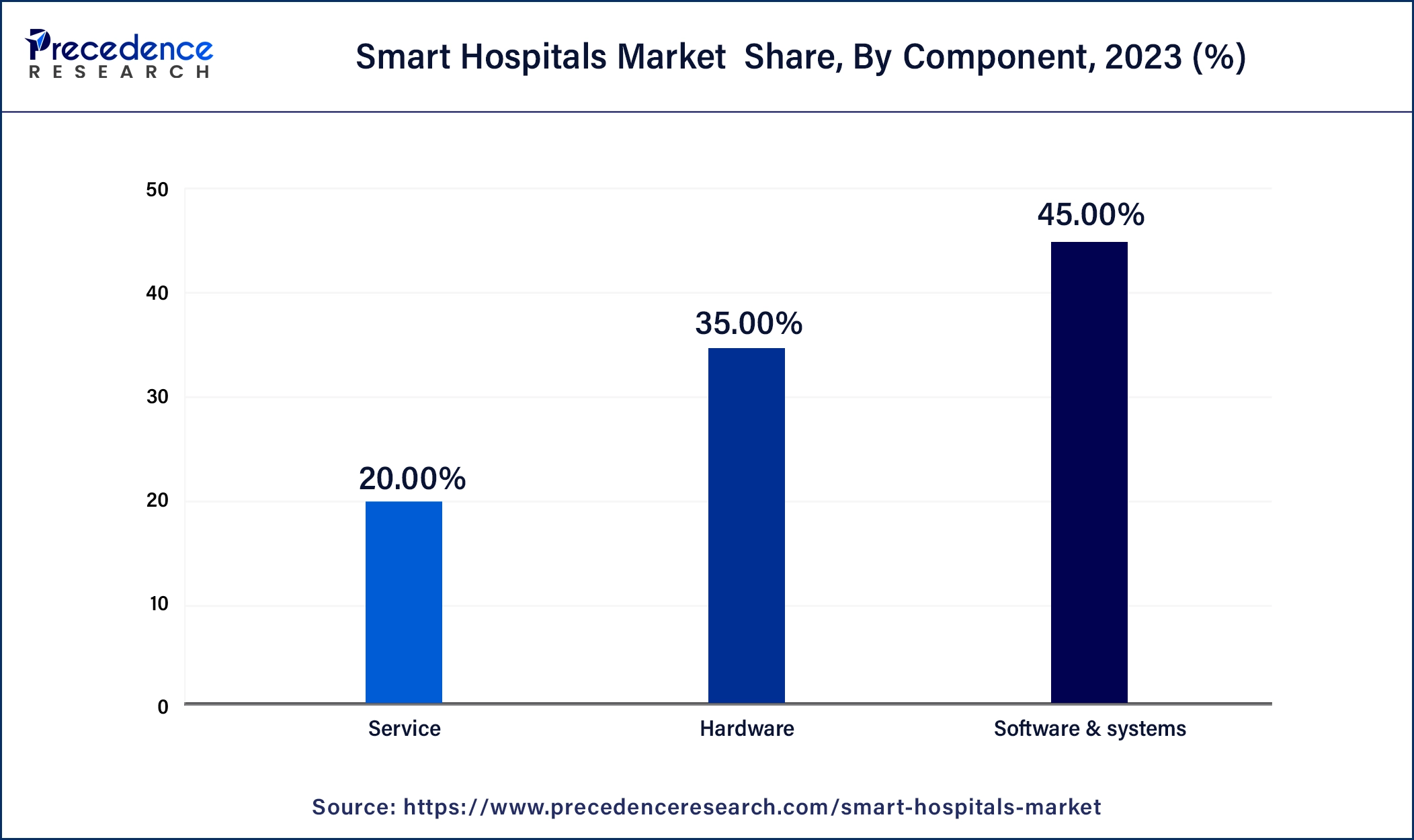May 2024
The global smart hospitals market size was USD 49.43 billion in 2023, calculated at USD 58.18 billion in 2024 and is projected to surpass around USD 296.87 billion by 2034, expanding at a CAGR of 17.7% from 2024 to 2034.
The global smart hospitals market size accounted for USD 58.18 billion in 2024 and is expected to be worth around USD 296.87 billion by 2034, at a CAGR of 17.7% from 2024 to 2034. The North America smart hospitals market size reached USD 16.31 billion in 2023.

The U.S. smart hospitals market size was estimated at USD 11.43 billion in 2023 and is predicted to be worth around USD 69.16 billion by 2034, at a CAGR of 17.78% from 2024 to 2034.

Based on region, North America dominated the market with largest revenue share in 2023. This can be attributed to the higher adoption rate of the automation, digital, and advanced technologies in the healthcare industry. The increasing importance of the healthcare sectors towards the GDP contribution of the US is a major factor that states the penetration of the smart hospitals in the region. Moreover, increased per capita healthcare expenditure in the US due to the increased demand for the latest and efficient therapeutics. Moreover, the increased penetration of telehealth and electronic health records in the region has resulted in the significant growth of the smart hospitals market in North America.
On the other hand, Europe is estimated to be the most opportunistic segment during the forecast period. This is due to the rising government expenditure on the development of healthcare infrastructure and adoption of digital technologies in the sector. Moreover, the rising number of private hospitals, clinics, and diagnostic centers in the region coupled with their heavy investments in the automation and digitalization is expected to significantly drive the market growth in the region.

The adoption of technologically advanced software and devices in the healthcare industry across the globe has evolved the traditional hospitals into smart hospitals. The adoption of advanced technologies was powered by the growing need to reduce the operational costs and increase profitability and offer enhanced patient care services. The emergence of the wireless connectivity and latest technologies like internet of things (IoT) and artificial intelligence (AI) are expected to rapidly boost the growth of the global smart hospitals market. The growing government and corporate investments in the digitalization of the healthcare sector to improve the operational efficiency is also a significant driver. The rising prevalence of various chronic diseases among the population and growing geriatric population has increased the need for the advanced and efficient healthcare services. Moreover, the rising healthcare expenditure is also benefitting the global smart hospitals market.
The rising number of hospital admissions owing to the rising prevalence of chronic diseases, road traffic accidents, growing geriatric population, and various other factors is creating a pressure on the healthcare system. The smart hospitals will help to serve the rapidly growing inflow of patients and provide affordable treatment for various diseases. The rapidly surging technologies like AI, IoT, robotics, augmented reality, and precision medicine are expected to provide cost-efficient and sustainable healthcare solutions, thereby significantly contributing towards the growth of the global smart hospitals market. The rising adoption of telemedicine, telehealth, and electronic health record has exponential contributions in the development of the smart hospitals market.
| Report Highlights | Details |
| Market Size in 2023 | USD 49.43 Billion |
| Market Size in 2024 | USD 58.18 Billion |
| Market Size by 2034 | USD 296.87 Billion |
| Growth Rate from 2024 to 2034 | CAGR of 17.7% |
| Largest Market | North America |
| Fastest Growing Market | Europe |
| Base Year | 2023 |
| Forecast Period | 2024 to 2034 |
| Segments Covered | Component, Product, Connectivity, and Region |
| Regions Covered | North America, Asia Pacific, Europe, Latin America, Middle East and Africa |
Based on the component, the software & systems segment dominated the largest revenue share in 2023. This is attributed to the increasing need to increase profitability by reducing the healthcare costs and improve the data management systems equipped in the smart hospitals. Furthermore, the increasing adoption of latest technologies like AI, AR, IoT, and VR is increasing the demand for the smart hospitals for its efficient services.

On the other hand, the services segment is estimated to be the most opportunistic segment during the forecast period. This is simply due to the lack of proper knowledge about handling the digital systems used in the smart hospitals setting, among the healthcare workers and professionals. Therefore, the third-party services are being increasingly adopted for the efficient utilization of advanced and various digital devices and software in order to achieve efficiency and low operational costs.
Based on the product, the telemedicine segment dominated the global smart hospitals market in 2023. This is simply due to the increased adoption of the telemedicine platforms among the consumers and the healthcare professionals. Further, the rising penetration of internet and rising adoption of smartphones along with the rising urban population has boosted the growth of this segment across the globe. According to ITU, around 4 billion people were using internet by the end of 2019. Most of the internet users operate through their smartphones. Doctors and physicians are now increasingly adopting the telehealth platforms for offering consultations and other services.
On the other hand, the electronic health records segment is estimated to be the fastest-growing segment during the forecast period. This is attributed to the increasing government initiatives to record the patients’ details and health related data that can be utilized for the treatment of the patient. For instance, Allscripts Healthcare Solutions entered into a strategic partnership with the US Orthopedic Alliance to introduce improved electronic health records.
Based on the connectivity, the wireless segment dominated the highest revenue share in 2023. This is simply attributed to the increased adoption of various wireless technologies such as internet, cloud-based servers, and Bluetooth. The wireless connectivity offers wireless communication, easy data transfer, and remote access to the stakeholder that boosts the adoption of the wireless connectivity in the smart hospitals across the globe.
Key Companies Share Insights
The market is moderately fragmented with the presence of several local companies. These market players are striving to gain higher market share by adopting strategies, such as investments, partnerships, and acquisitions & mergers. Companies are also spending on the development of improved products. Moreover, they are also focusing on maintaining competitive pricing.
In January 2020, KT Corporation and Samsung Medical Center collaborated to develop a 5G Smart Hospital.
The various developmental strategies like collaborations, acquisition and new product launches with latest and innovative features fosters market growth and offers lucrative growth opportunities to the market players.
Segments Covered in the Report
By Component
By Product
By Connectivity
By Geography
For inquiries regarding discounts, bulk purchases, or customization requests, please contact us at sales@precedenceresearch.com
No cookie-cutter, only authentic analysis – take the 1st step to become a Precedence Research client
May 2024
January 2025
January 2025
December 2024